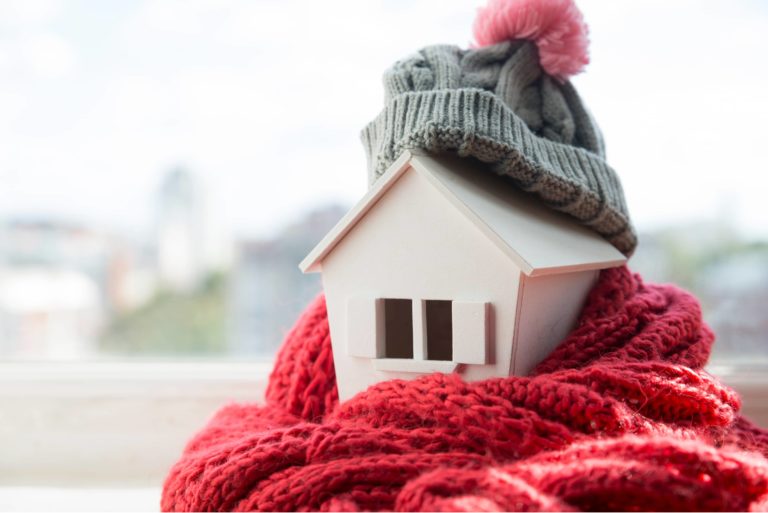Table of Contents
Stay Cozy by Implementing These Helpful Tips Today
“Brrr, it’s cold in here!”
It’s a common thought during chilly winter months, and is usually followed by you bumping up the temperature a couple of degrees on your thermostat, or layering on another sweater.
But rather than bulking yourself up like the Michelin Man or paying your utility company even more of your hard-earned money this winter, try these 10 ways to keep your home warm instead.
Cover Your Windows in Plastic Sheets
It seems old school, but using window kits from your hardware store to hang plastic sheeting over your windows is a great way to block drafts and insulate your home. The plastic sheets add a barrier between you and the tiny gaps around your windows, which means you won’t feel the chill of winter air seeping through.
The downside to hanging plastic on your windows is that it can obstruct your view, so if seeing outside is important to you, you may want to try another technique to keep your home warm.
Hang Heavy Curtains
Thick blackout curtains can help block some of the drafts that leak in through your windows, and you can easily move them aside when you need to let in light or access your window.
Hang your curtains above the top of the window frame to give coverage all the way around. Make sure they’re long and wide enough to provide coverage.
You also could hang heavy curtains to block off rooms you want to keep warm, especially if they’re near areas of the home that tend to be more chilly. For example, some people hang curtains to separate their living room from the entryway of their home, where opening and closing the door puts a chill in the air.
Seal Drafts Around Windows and Doors
Insulating strips that fill gaps between your doors and windows and their frames are inexpensive to buy at your local hardware store. They also are easy to install and stick on using an adhesive strip, so you can begin blocking drafts in minutes.
Add Insulation
If your house is generally too cold in the winter, it may need more insulation. Older homes tend not to have quite enough insulation, so it’s a smart investment to add it.
Standard fiberglass installation that comes in rolls is likely the least expensive, but blown-in or spray-foam insulation is often easier to install in homes with finished walls. It can be more expensive, however.
Use a Smart Thermostat
If your focus is on saving money and keeping your home warm while you’re home, a smart or programmable thermostat can help you with that.
Create a schedule for your thermostat to follow, so the heat kicks on before you get out of bed in the morning, but lowers the temperature after you’ve left for work. The thermostat can warm up the house before you arrive home, too! And if you opt for a smart thermostat with Wi-Fi, you can even control it from your smartphone.
Don’t Block Vents
Your air vents need room to do their job, so if they’re blocked by furniture or other home decor items, you’ll want to rearrange them so they aren’t inhibiting air flow.
All air vents need at least six inches of clearance around furniture, curtains, and other items for adequate ventilation.
Change Your Furnace’s Air Filter
If your home is heated with a forced-air system, you should be changing your air filter no less frequently than every three months. If you have pets, live in an area with lots of allergens, or feel like your house is too dusty, you can change it as often as every month.
A full air filter makes your blower work harder, which can mean your home feels less warm than it should. Be sure to check the MERV value of the air filters you buy and compare them to what is recommended in your furnace’s manual.
Close Vents in Rooms You Aren’t Using
If you rarely use certain rooms in your house, why pay to heat them? As long as they don’t contain important plumbing that could freeze, shut their air vents, or turn off their radiators, and close the door.
This decreases the square footage your HVAC system must heat and could help the rest of your home feel warmer as a result.
Properly Maintain Your HVAC System
Regular HVAC maintenance improves overall system performance. Plan to have your unit inspected and cleaned at least twice per year.
Regular maintenance also decreases the likelihood of needing frequent residential heating repairs because the technician can catch minor issues before they become big problems.
Install an Upgraded HVAC System
HVAC systems can get old and not work as well as they used to. Well cared-for systems can last between 15 and 20 years, but that doesn’t mean they’re working at full efficiency and capacity all of that time.
In fact, unless you’re buying top-of-the-line equipment, your system probably isn’t working at its best after only 10 years. As a result, your home might not be as warm as it could be in the winter.
Upgrading your HVAC system to the latest, energy-efficient model could keep you more comfortable indoors, and it will also cut down on your utility bills.








